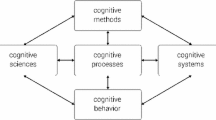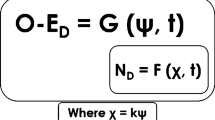Abstract
This paper explores the performance of a simple model agent using a reactive controller in situations where, from an external perspective, a solution that relies on internal states would seem to be required. In a visually-guided orientation task with sensory inversion and an object discrimination task a study of the instantaneous response properties and time-extended dynamics explain the non-reactive performance. The results question common intuitions about the capabilities of reactive controllers and highlight the significance of the agent’s recent history of interactions with its environment in generating behaviour. This work reinforces the idea that embodied behaviour exhibits properties that cannot be deduced directly from those of the controller by itself.
Preview
Unable to display preview. Download preview PDF.
Similar content being viewed by others
References
Beer, R.D.: Toward the evolution of dynamical neural networks for minimally cognitive behavior. In: Proc. of Simulation of Adaptive Behavior. MIT Press, Cambridge (1996)
Beer, R.D.: The dynamics of active categorical perception in an evolved model agent. Adaptive Behavior 11(4), 209–243 (2003)
Chiel, H.J., Beer, R.D.: The brain has a body: Adaptive behavior emerges from interactions of nervous system, body and environment. Trends in Neurosciences 20, 553–557 (1997)
Clark, A., Thornton, C.: Trading spaces: computation, representation and the limits of uninformed learning. Behavioral and Brain Sciences 20, 57–90 (1997)
Dewey, J.: The reflex arc concept in physchology. Psychological Review 3, 357–370 (1896)
Di Paolo, E.A., Harvey, I.: Decisions and noise: the scope of evolutionary synthesis and dynamical analysis. Adaptive Behavior 11(4), 284–288 (2003)
Harvey, I.: The microbial genetic algorithm (1996) (unpublished manuscript)
Lashley, K., Schiller, C.: Instinctive behavior: the development of a modern concept. International University Press, New York (1957)
Merleau-Ponty, M.: The Structure of Behavior. Beacon Press (1967)
Nolfi, S.: Power and the Limits of Reactive Agents. Neurocomputing 49, 119–145 (2002)
Pfeifer, R., Scheier, C.: Understanding Intellingence. MIT Press, Cambridge (1999)
Scheier, C., Pfeifer, R., Kunyioshi, Y.: Embedded neural networks: exploiting constraints. Neural Networks 11, 1551–1569 (1998)
Varela, F., Thompson, E., Rosch, E.: The Embodied Mind: Cognitive Science and Human Experience. MIT Press, Cambridge (1991)
Author information
Authors and Affiliations
Editor information
Editors and Affiliations
Rights and permissions
Copyright information
© 2005 Springer-Verlag Berlin Heidelberg
About this paper
Cite this paper
Izquierdo-Torres, E., Di Paolo, E. (2005). Is an Embodied System Ever Purely Reactive?. In: Capcarrère, M.S., Freitas, A.A., Bentley, P.J., Johnson, C.G., Timmis, J. (eds) Advances in Artificial Life. ECAL 2005. Lecture Notes in Computer Science(), vol 3630. Springer, Berlin, Heidelberg. https://doi.org/10.1007/11553090_26
Download citation
DOI: https://doi.org/10.1007/11553090_26
Publisher Name: Springer, Berlin, Heidelberg
Print ISBN: 978-3-540-28848-0
Online ISBN: 978-3-540-31816-3
eBook Packages: Computer ScienceComputer Science (R0)




